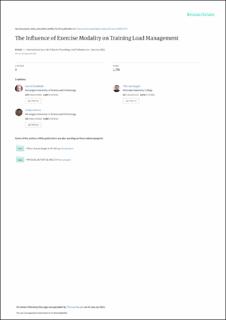| dc.description.abstract | Purpose: To provide novel insight regarding the influence of exercise modality on training load management by (1) providing a theoretical framework for the impact of physiological and biomechanical mechanisms associated with different exercise modalities on training load management in endurance exercise and (2) comparing effort-matched low-intensity training sessions performed by top-level athletes in endurance sports with similar energy demands. Practical Applications and Conclusions: The ability to perform endurance training with manageable muscular loads and low injury risks in different exercise modalities is influenced both by mechanical factors and by muscular state and coordination, which interrelate in optimizing power production while reducing friction and/or drag. Consequently, the choice of exercise modality in endurance training influences effort beyond commonly used external and internal load measurements and should be considered alongside duration, frequency, and intensity when managing training load. By comparing effort-matched low- to moderate-intensity sessions performed by top-level athletes in endurance sports, this study exemplifies how endurance exercise with varying modalities leads to different tolerable volumes. For example, the weight-bearing exercise and high-impact forces in long-distance running put high loads on muscles and tendons, leading to relatively low training volume tolerance. In speed skating, the flexed knee and hip position required for effective speed skating leads to occlusion of thighs and low volume tolerance. In contrast, the non-weight-bearing, low-contraction exercises in cycling or swimming allow for large volumes in the specific exercise modalities. Overall, these differences have major implications on training load management in sports. | en_US |
